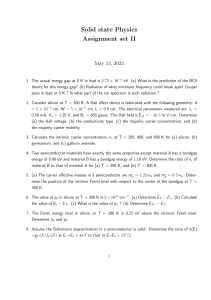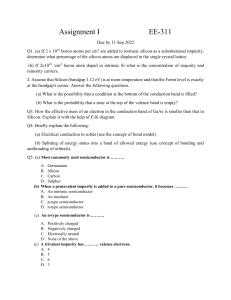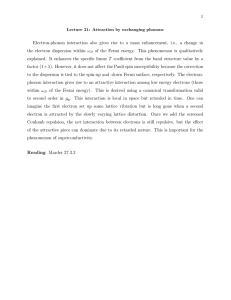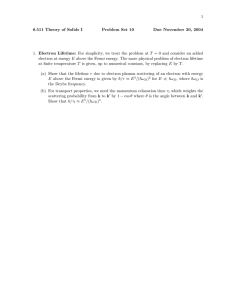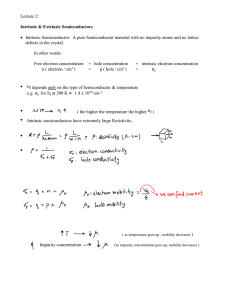Semiconductor Physics Assignment: Fermi Level, Doping, Conductivity
advertisement
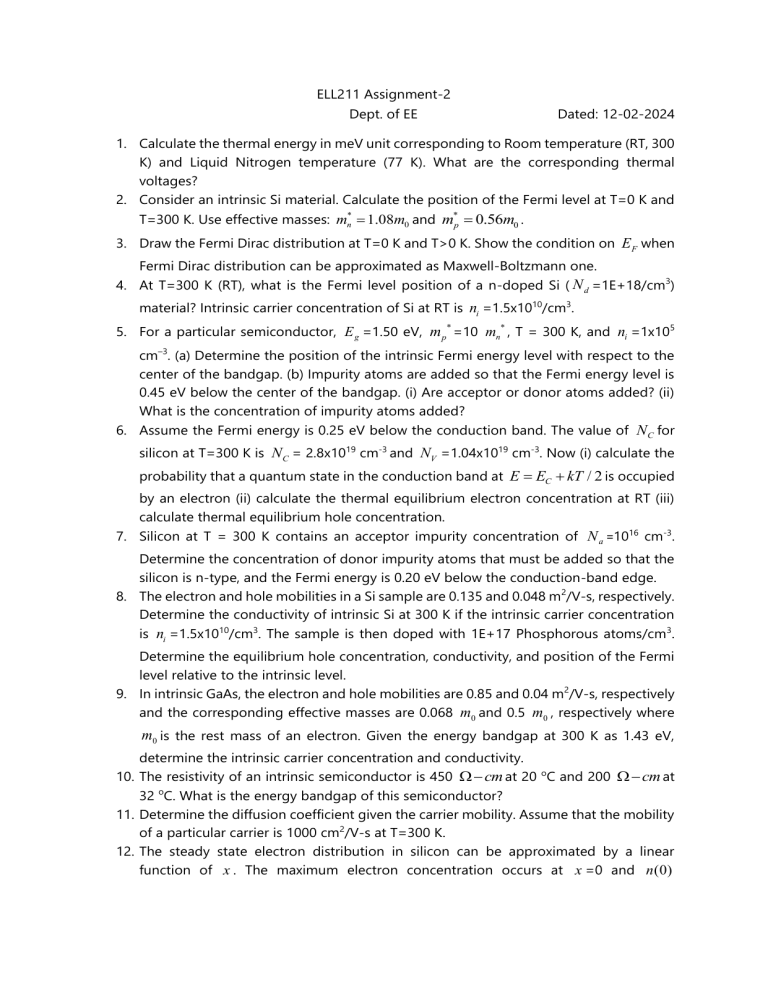
ELL211 Assignment-2 Dept. of EE Dated: 12-02-2024 1. Calculate the thermal energy in meV unit corresponding to Room temperature (RT, 300 K) and Liquid Nitrogen temperature (77 K). What are the corresponding thermal voltages? 2. Consider an intrinsic Si material. Calculate the position of the Fermi level at T=0 K and T=300 K. Use effective masses: mn* = 1.08m0 and m*p = 0.56m0 . 3. Draw the Fermi Dirac distribution at T=0 K and T>0 K. Show the condition on E F when Fermi Dirac distribution can be approximated as Maxwell-Boltzmann one. 4. At T=300 K (RT), what is the Fermi level position of a n-doped Si ( N d =1E+18/cm3) material? Intrinsic carrier concentration of Si at RT is ni =1.5x1010/cm3. 5. For a particular semiconductor, E g =1.50 eV, m p* =10 mn* , T = 300 K, and ni =1x105 cm–3. (a) Determine the position of the intrinsic Fermi energy level with respect to the center of the bandgap. (b) Impurity atoms are added so that the Fermi energy level is 0.45 eV below the center of the bandgap. (i) Are acceptor or donor atoms added? (ii) What is the concentration of impurity atoms added? 6. Assume the Fermi energy is 0.25 eV below the conduction band. The value of N C for silicon at T=300 K is N C = 2.8x1019 cm-3 and NV =1.04x1019 cm-3. Now (i) calculate the probability that a quantum state in the conduction band at E = EC + kT / 2 is occupied by an electron (ii) calculate the thermal equilibrium electron concentration at RT (iii) calculate thermal equilibrium hole concentration. 7. Silicon at T = 300 K contains an acceptor impurity concentration of N a =1016 cm-3. Determine the concentration of donor impurity atoms that must be added so that the silicon is n-type, and the Fermi energy is 0.20 eV below the conduction-band edge. 8. The electron and hole mobilities in a Si sample are 0.135 and 0.048 m2/V-s, respectively. Determine the conductivity of intrinsic Si at 300 K if the intrinsic carrier concentration is ni =1.5x1010/cm3. The sample is then doped with 1E+17 Phosphorous atoms/cm3. Determine the equilibrium hole concentration, conductivity, and position of the Fermi level relative to the intrinsic level. 9. In intrinsic GaAs, the electron and hole mobilities are 0.85 and 0.04 m2/V-s, respectively and the corresponding effective masses are 0.068 m0 and 0.5 m0 , respectively where m0 is the rest mass of an electron. Given the energy bandgap at 300 K as 1.43 eV, determine the intrinsic carrier concentration and conductivity. 10. The resistivity of an intrinsic semiconductor is 450 − cm at 20 oC and 200 − cm at 32 oC. What is the energy bandgap of this semiconductor? 11. Determine the diffusion coefficient given the carrier mobility. Assume that the mobility of a particular carrier is 1000 cm2/V-s at T=300 K. 12. The steady state electron distribution in silicon can be approximated by a linear function of x . The maximum electron concentration occurs at x =0 and n (0) =2x1016/cm3. At x =0.012 cm, the electron concentration is 5x1015/cm3. If the electron mobility is 1350 cm2/V-s, determine the electron diffusion current density (at RT). 13. Show that the minimum conductivity of a semiconductor sample occurs when n0 = ni p n . 14. Consider a semiconductor bar with w = 0.1 mm, t = 10 µm, and L = 5 mm as shown in the figure below. For Bz = 10 kG in the direction shown (1 kG = 10–5 Wb/cm2) and a current of 1 mA, we have VAB = –2 mV and VCD = 100 mV. Find the type, concentration, and mobility of the majority carrier. 15. Consider n-type silicon material doped at N d =5x1015 cm–3. It is found that Fn − EF =1.02x10–3 eV. (a) What is the excess carrier concentration? (b) Determine Fn − Emidgap . (c) Calculate Emidgap − Fp . Fn , Fp are quasi-Fermi levels. 16. Consider a bulk semiconductor heterostructure formed like: Al0.4Ga0.6As/GaAs/Al0.4Ga0.6As. Bandgap of AlxGa1–xAs is Eg ( x) = 1.424 + 1.247 x eV for x <0.45. Consider the electron affinity ( ) obeying the relation: ( x) = 4.07 −1.1x eV for x <0.45. (a) Draw the band diagram for this heterostructure. (b) What will be the Photoluminescence (PL) emission wavelength out of the GaAs region if we excite this system with a laser of energy more than its bandgap? (c) If you want to increase the PL emission energy, what structural change should you do?
